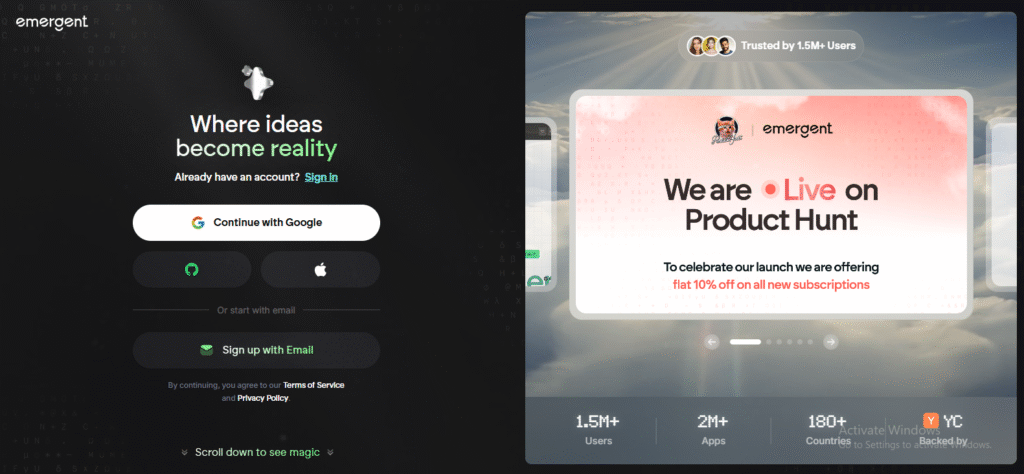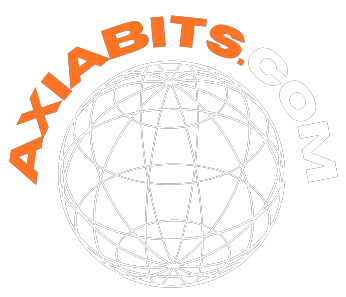Introduction
Artificial Intelligence has evolved beyond just generating text or images — it’s now entering the realm of full-stack software development. What if an AI could plan, code, and debug an entire web application from scratch? That’s exactly what we set out to explore in our recent experiment: building a full-stack Netflix clone using Emergent AI.

In this blog, we’ll walk you through every stage of the journey — from the initial prompt to the final, functioning Netflix-like application. You’ll see how AI handled everything: backend APIs, database integration, user authentication, and even video streaming logic.
By the end, you’ll know exactly how powerful emergent AI systems have become — and whether this could really be the beginning of a new coding era. Explore how Emergent AI built a full-stack Netflix clone from scratch — from planning and coding to debugging and streaming video.
The Challenge: Can AI Build Netflix?
We started with a bold question:
Can AI independently build a working Netflix clone — complete with user authentication, browsing, and video streaming features — from a single prompt?

This wasn’t about writing a few lines of code. It was a test of whether an AI could:
- Plan a project architecture
- Choose appropriate technologies
- Generate complex backend and frontend code
- Debug its own errors
- Deliver a fully functional web app
The concept of “Emergent AI” — an AI that develops unplanned, complex capabilities as it scales — has taken the world by storm. So, we decided to challenge this idea in a practical, real-world project. Don’t just read about it — build with Emergent AI. Whether you’re a developer, startup founder, or tech enthusiast, this platform empowers you to create complete applications with simple prompts. Try Emergent AI today — it’s free to start!
The Initial Prompt and AI Setup
We began by providing the AI with a detailed prompt describing the goal:
“Build a full-stack Netflix clone that includes user authentication, a video browsing interface, and streaming capabilities. Use modern frameworks and a scalable backend.”
From there, we gave it the autonomy to decide:
- Which tech stack to use
- How to structure the app
- How to handle user data, media files, and sessions
Within seconds, the AI began outlining the architecture — much like an experienced full-stack developer would.
AI Planning: Tech Stack & Architecture
Here’s what the AI came up with:
- Frontend: React.js (with modern hooks and context for state management)
- Backend: Node.js with Express
- Database: MongoDB (for scalability and flexibility)
- Authentication: JSON Web Tokens (JWT)
- Streaming: HTML5 video player integrated with secure API endpoints
It even suggested using Cloudinary or AWS S3 for hosting video files, ensuring smooth and reliable streaming.
The AI structured the application into two parts:
- Frontend (React): Handles the user interface, navigation, and content browsing.
- Backend (Node.js/Express): Manages authentication, data retrieval, and video delivery.
This planning phase felt eerily human — the AI didn’t just code; it reasoned through architectural choices. From React to Node.js, it automatically selects the best tools for your project. Save hours of setup and focus on innovation. Join Emergent AI now and start building smarter.
Building the Backend: Database & API Generation
Next, the AI started coding the backend.
It began with setting up the Express server and connecting it to a MongoDB instance. The generated code automatically included routes for:
- User signup/login
- Fetching movie data
- Handling video streaming endpoints
Example snippet from the AI’s generated code:
app.get(‘/api/movies/:id/stream’, authenticateUser, (req, res) => {
const videoPath = `videos/${req.params.id}.mp4`;
const stream = fs.createReadStream(videoPath);
res.setHeader(‘Content-Type’, ‘video/mp4’);
stream.pipe(res);
});
It even implemented token-based authentication using JWT, enabling secure login and personalized sessions for users.
The database schema included models for Users, Movies, and Watchlists, allowing users to save favorites — just like Netflix. Generate powerful APIs, connect databases, and deploy scalable applications — all in minutes.
Sign up for Emergent AI and see how effortless backend development can be.
Coding the Frontend: User Interface & State Management
Once the backend was functional, the AI switched gears to build the frontend.

It initialized a React project, structured the folder hierarchy, and generated multiple components:
- Login.jsx
- Signup.jsx
- MovieList.jsx
- Player.jsx
- Navbar.jsx
The interface was designed for simplicity — showcasing thumbnails, categories, and a clean navigation bar.
The AI used Context API for state management, handling login state, user data, and watch history.
It also implemented dynamic routing:
<Route path=”/watch/:id” element={<Player />} />
This allowed seamless transitions from browsing to watching a movie — all powered by the APIs it previously built. Learn how you can Create an Audiobook with Your Cloned AI Voice in ElevenLabs — and discover how AI-generated voices can bring your digital projects to life, just like Emergent AI brings apps to reality.
The First Big Bug: Watching the AI Debug Itself
Of course, no software project is complete without bugs.
During the integration phase, the app encountered its first major issue — the video player failed to stream properly. The AI detected a CORS (Cross-Origin Resource Sharing) error when fetching media from the backend.
What happened next was fascinating.
The AI analyzed its own console logs, identified the CORS issue, and autonomously added middleware in the backend:
app.use(cors({ origin: ‘*’, methods: [‘GET’, ‘POST’] }));
After making this fix, the app successfully streamed the first video — a moment that felt almost surreal.
It wasn’t just executing instructions — it was reasoning, debugging, and learning in real time. With Emergent AI’s self-learning capabilities, you can watch it fix logic errors, optimize performance, and deliver ready-to-launch code. Build your first AI-powered project with Emergent AI today.
Final Result: A Working Netflix Clone!
After hours of continuous generation, refinement, and debugging, we had a working Netflix clone — built almost entirely by AI.

The finished app included:
- User signup/login
- Content browsing by genre
- Thumbnail previews
- Responsive React frontend
- Secure video streaming
- Dynamic routing
- JWT authentication
It wasn’t pixel-perfect, but it was impressively functional — and the entire full-stack workflow came from AI-generated code.
When tested locally, the interface felt smooth and modern. Users could sign in, explore a movie library, and stream videos directly from the browser — all without a single line of human-written code.
My Thoughts: Is This the End of Coding?
Watching Emergent AI handle both backend and frontend development raised a powerful question — what happens to human developers when AI can build software independently?
Here’s the truth:
AI isn’t replacing developers just yet. It still needs clear direction, structured prompts, and human validation to ensure efficiency, security, and maintainability.
However, this experiment proved one thing beyond doubt:
AI can now build production-level applications faster than ever before.
This doesn’t spell the end of coding — it marks the evolution of how we code.
Instead of writing line by line, developers of the future might focus on:
- Designing better prompts
- Validating AI-generated logic
- Integrating creativity, UX, and business goals
Emergent AI transforms developers from coders into project architects and AI collaborators.
Key Takeaways
- AI can plan full-stack architecture intelligently, choosing modern, efficient technologies.
- Emergent AI models handle complex logic, from user authentication to video streaming.
- Self-debugging capabilities show how close AI is to autonomous software creation.
- Human oversight remains essential to refine, optimize, and secure the final product.
- This marks the beginning of AI-assisted full-stack development, where humans guide and AI executes.
AI isn’t just transforming code — it’s revolutionizing creativity, too.
Discover how ElevenLabs Is Changing the Game for Developers by providing lifelike voice synthesis and API tools that let creators integrate advanced speech technology directly into their apps.
Build Smarter with AI-Powered Solutions
At Axiabits, we help innovators, startups, and digital businesses bring AI-driven ideas to life — just like the Netflix clone project powered by Emergent AI. Our team specializes in building custom AI solutions, Webflow integrations, and automation systems that accelerate your digital growth.
Whether you’re looking to:
- Integrate AI-based workflows into your web or SaaS platform
- Build custom full-stack applications powered by intelligent automation
- Connect your tools like Webflow, Shopify, or HubSpot with AI capabilities
- Or simply turn your idea into a working MVP with AI assistance
—We’re here to make it happen.
Let’s create something extraordinary together! Book now and let’s get started!
Conclusion
The journey of building a full-stack Netflix clone with Emergent AI wasn’t just a coding experiment — it was a glimpse into the future of software development.
What once required a team of engineers and weeks of work can now be prototyped by an AI in hours.
Emergent AI doesn’t just generate code — it understands context, plans architecture, and learns from its mistakes.
While human creativity and critical thinking remain irreplaceable, AI is becoming a powerful collaborator — one that can accelerate innovation beyond what we imagined possible.
As we move forward, the partnership between AI and developers will define the next era of digital creation.
And who knows? The next Netflix, Spotify, or YouTube might just be built — not by a human — but by an Emergent AI. Emergent AI isn’t just a coding assistant — it’s your full-stack partner. Turn your ideas into production-ready apps faster than ever. Join Emergent AI — start creating the future now
Disclaimer
This article features affiliate links, which indicate that if you click on any of the links and make a purchase, we may receive a small commission. There’s no additional cost to you, and it helps support our blog, allowing us to continue delivering valuable content. We solely endorse products or services that we think will benefit our audience.
Frequently Asked Questions
What technologies did the AI use to build the Netflix clone?
The AI selected React.js, Node.js, Express, and MongoDB — along with JWT for authentication and an HTML5 player for streaming.
Did AI write the entire code?
Yes. From backend APIs to frontend components, the AI generated every line of code and even autonomously debugged issues.
Did the project include user authentication?
Absolutely. Users could sign up, log in, and have their sessions verified using token-based authentication.
Could the AI handle video streaming logic?
Yes. It built streaming endpoints that delivered videos in chunks — mimicking Netflix’s playback experience.
What’s next for AI-driven development?
Expect more autonomous, collaborative coding environments, where developers guide high-level ideas while AI handles execution and optimization.







